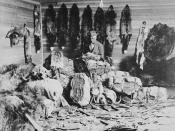The Lenape people were natives of the areas we now call New Jersey, eastern Pennsylvania, southeastern New York State, Northern Delaware and a small part of southeastern Connecticut. Before the Europeans arrived, Lenapes had survived by living in communities where work was shared and everyone was conscious of the complexities of the natural world around them. The Europeans however did not share that same consciousness and ended up devastating the Lenapes' culture by introducing the fur trade, diseases, and assimilation tactics.
If the destruction of the Lenapes' way of life could be blamed on one thing, it would be the introduction of the fur trade. Dutch explorer, Henry Hudson, was sent out to find a new passage to the Orient. Instead, his travels took him to the Delaware River and Hudson River where he first met the Lenapes on shore. Early accounts of these meetings between Europeans and natives were described as relatively peaceful, as both groups of people were obviously intrigued by each other.
Soon, the Dutch realized that working with these natives would benefit them economically. So began the fur trade that eventually would turn the Lenape people against each other and their own families.
"The fur trade initiated by the Dutch created an awareness of territoriality among the Indians in the Hudson Valley." (ulster.com) This quote explains the rivalry that took place once the Dutch started trading with the natives. Lenapes were pressured to bring more and more furs to the Europeans, and soon tribes found that they killed all the animals they could within their territory. This forced certain tribes to go into other territories and the results were blood shed. For all the labor and strain the fur trade caused among the Lenapes, all they got in return were "European luxuries" such as cloth, glass,


